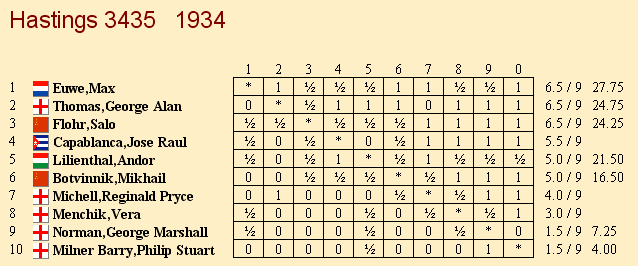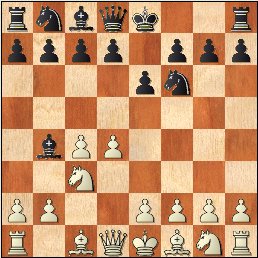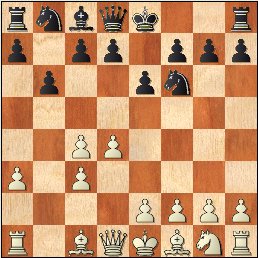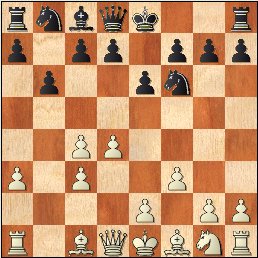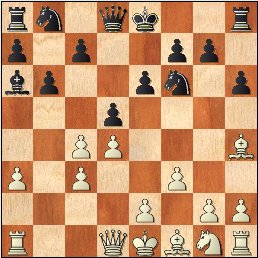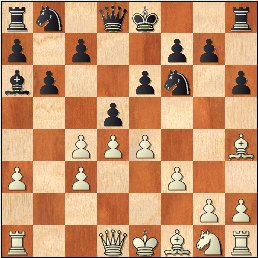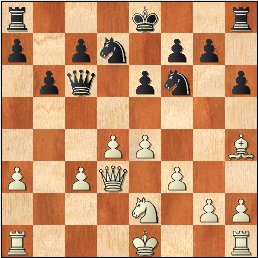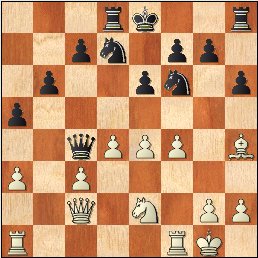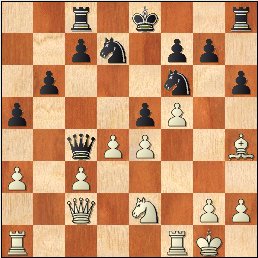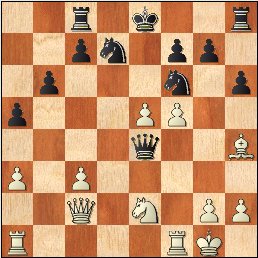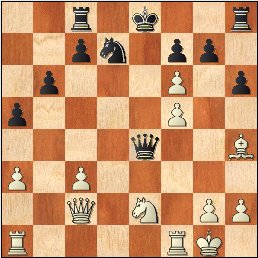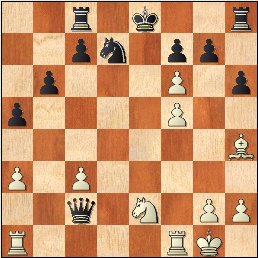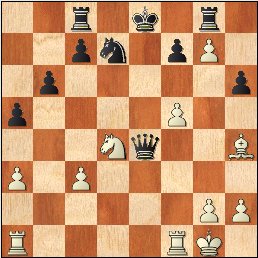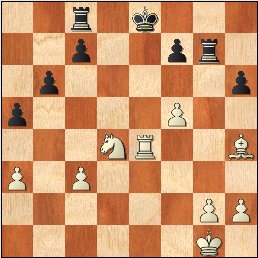All
the |
(Navigation bar
directly below.)
*******
© A.J. Goldsby, 2015.
(All rights reserved.)
****************
Click HERE
to see my
Chess Items.
****************
****************
Buy a book
from Amazon.com
(And help me out as well!)
****************
Click HERE
...
to see a list of the businesses that help to sponsor all of
my chess efforts.
|
|
******************************************************************************************* At
the time that this event
was played, Euwe and Flohr were at the peak of
their powers ... so the fact that these two tied for first should come as
no surprise. ******************************************************************************************* Since
Euwe eventually became World Champion, was undefeated, and would have
probably won this event on TB ... ******************************************************************************************* Max
Euwe - Sir G.A. Thomas
|
|
Click here to see an explanation of all the symbols that I commonly use when annotating a game. Click
here
to re-play
this game ... on another
server. |
Hastings, England. {UK} (1934 - 1935)
A very famous game of chess ...
in lieu of the fairly recent passing of GM Andor Lilienthal, ... ... ...
(http://www.chessbase.com/newsdetail.asp?newsid=6318)
... I thought it would be appropriate to annotate this game and post it on my website.
[While I had been thinking about this idea for some time ... and I have
studied this game many times ... the date that I actually began this project was: Wed; June 2nd, 2010.]
No ratings are given for these players, as
no FIDE rating list existed at the time that this game was played. However, checking
the ratings of the chess historian Jeff Sonas, (http://db.chessmetrics.com/);
for January, 1935 ... ... ... is a real eye-opener! Capa is given as 2632 - no shock there. However, A.
Lilienthal checks in at a surprising 2702!!!
[Lilienthal's rating should be considered to be somewhat unreliable, (over-inflated);
it is based on a very small number of games played during just a few events.]
I must hasten to add that Capa was the "big-name" player here, (at the time that this game was played); while his opponent {Lilienthal} was a virtual unknown to the world's general chess community.
*******************************************************************************************
Andor
Lilienthal; 1911 - 2010.
{A brief biography, by A.J. Goldsby I.}
<< A Lilienthal was one of the greats of chess. While never truly a contender for the top
spot in the World Crown, he was certainly an outstanding player. A sampling of his
best games shows he defeated many of the greatest names in chess, many of these
games were played in grand style.
(Lilienthal played just about all the World Champions - from E. Lasker to M. Botvinnik;
defeating many of them.)
While he was born in Moscow in 1911, both his mother and his father were of Hungarian descent. His parents took him with them when they moved back to Hungary approximately two years after A. Lilienthal was born.
Four of his better early results would be:
First place at Stubnianske Teplice, 1930. (+8, =2, -2); ahead of Pirc and Flohr.
Second at Hastings, England, 1933-34. (+5, =3, -1); equal with Alekhine.
First at Ujpest, 1934. (+7, = 8, -0); ahead of Pirc and Flohr.
Gold medal on Board Two (for Hungary) and best overall score in 1935. (+ 11, = 8, - 0.)
Later he moved to the Soviet Union and
became a chess trainer there. One of his best results ever was to take FIRST in the
1940 U.S.S.R. Championships,
[+ 8, = 11] (Equal with Bondarevsky, but ahead of
many great players, such as Smyslov, Keres, Boleslavsky and even the great Mikhail Botvinnik.).
Lilienthal was one of the last persons still living of the group that received their GM title (from FIDE) in 1950.
In 1965, he retired from active play.
In 1976, he returned to his native homeland, (Hungary); the land of his people. In
2010, a living legend of chess ...
perhaps the last link to a grand generation ... left the
sphere of the living. {He was 99.} >>
Most people consider this to be perhaps Lilienthal's best - and most famous - game.
1.d4 Nf6; 2.c4 e6; 3.Nc3 Bb4; (pin, part of a strategy)
The Nimzo-Indian.
|
|
rnbqk2r/pppp1ppp/4pn2/8/1bPP4/2N5/PP2PPPP/R1BQKBNR w
What started as a bizarre and somewhat off-beat idea in the mind of Nimzovich has evolved into one of the most played and trusted lines in the whole of the QP-opening systems.
(Masters play BOTH sides of this position, a sure sign of their vitality and their overall
reliability!)
4.a3, ('!?') [Tempo, structure.]
The Samisch System. (Click here
to explore this opening system.)
White wins the Bishop pair and Black strengthens White's center ... but at the cost of time and also White gets doubled QBP-pawns.
[For more information, see MCO-15. (Beginning on page # 536. See also page # 557, all columns and notes.)]
I found 9 or 10 instances if Lilienthal using 4.a3!? in the games database, most of these resulted in a win for White.
(He also used other variations, like Rubinstein's move of 4.e3. He also used many other systems to combat the Nimzo-Indian as well.)
[ Capa generally preferred: 4.Qc2, "+/=" here in this position. ]
4...Bxc3+; 5.bxc3 b6;
(fianchetto)
An interesting idea, Black tries to immediately free his Q-Bishop and also gets a little Q-side play.
|
|
rnbqk2r/p1pp1ppp/1p2pn2/8/2PP4/P1P5/4PPPP/R1BQKBNR w
[
The main line (today) is: 5...c5;
which is more in the spirit of the creator's vision for this opening.
(<<Fix, blockade, destroy!>>)
For one modern example of this line, please see the GM contest:
GM Teimour Radjabov (2729) - GM Viswanathan
Anand (2779);
ICT / 16th Melody-Amber (rapid) Monte Carlo, (R#02) /
18,03,2007.
(Black won a nice game, 0-1 in a total of fifty-three {53} moves.)
*****************************************************************
5...d7-d5; was the main line for many years. [See MCO-15; page # 557,
column # 49 and all notes that pertain to this line.]
]
6.f3, ('!?') [time - block the center]
Logical - White says (in effect) that the placement of your QB ... {on the long diagonal} ... will be completely ineffective.
|
|
rnbqk2r/p1pp1ppp/1p2pn2/8/2PP4/P1P2P2/4P1PP/R1BQKBNR b
[ A natural try here is: RR 6.Nf3, "+/=" (followed by normal development). ]
6...d5!?; (space, center)
This was one of the top choices ... for that time period ... but has been superseded today by a different opening plan.
[
In 2010, the Fritz "Power-Book" gives the following continuation here:
(>/=)
6...Nc6; 7.e4 Ba6;
8.Bg5 h6; 9.Bh4 Na5;
10.Qa4 Qc8; 11.Nh3 Qb7;
12.Nf2,
"+/=" (space, mobility)
and White has a small edge here.
IM Vincent McCambridge (2465) - GM Gennadi Sosonko (2560); [E24]
ICT / NY International Open (R#03) New York, NY / USA, 1984.
{Drawn in 29 total moves.}
]
7.Bg5, (thematic - for QS openings)
This is a nice pin, but (to me) it is not entirely clear where White's QB really belongs in this opening.
[ RR The top line (today) is: 7.cxd5, "+/=" -- MCO-15 and the Fritz "Power-Book." ]
7...h6; ("To take ... or not to ...")
Black immediately "puts the question" to White's Bishop on g5. (I like this, and it looks smart to do this ASAP.)
[ RR 7...Bb7; - PB. ]
The usual rule of thumb is that when your opponent plays ...h7-h6; you should maintain the pressure on the diagonal and play B/g5-h4.
(Now to completely break the pin, Black must play ...g7-g5; which would greatly weaken his K-side.)
8.Bh4 Ba6;
(diagonal - hits c4)
This is a logical double attack of the White QBP on c4. However, it was definitely not the only playable move, both 8...0-0; and also 8...Bb7; were also possible here.
|
|
rn1qk2r/p1p2pp1/bp2pn1p/3p4/2PP3B/P1P2P2/4P1PP/R2QKBNR w
This is the current position on the board. Black's position is certainly reasonable here, the machine actually favors the second player's side of the board ... but only by a very small increment. (- .12) [I should also point out, that - in just two or three moves - the box will completely reverse itself and favor White ... by nearly a quarter of a point. The point? Many times, the machine's evaluations in the opening phase of the game are not really that helpful or meaningful, especially in positions that are close to being level.]
9.e4!?, (Maybe - '!')
[space]
This is an energetic play in the center, and many books {and various authors} have praised this move - as being the best and most energetic
opening idea for White.
(However, it was NOT the only possible move here for White!)
[ '!' - GM A.
Soltis. ]
|
|
rn1qk2r/p1p2pp1/bp2pn1p/3p4/2PPP2B/P1P2P2/6PP/R2QKBNR b
I should add that the machines don't like this move. However, this is probably one of those cases where a chess engine's evaluation should NOT be the only consideration in the decision of whether or not to play this move for White!
*********************************************************************************************************
I want to strongly emphasize something here, and I will do so -
even at the risk of repeating myself. Nearly every time that I have seen this game in print, the authors ALWAYS award 9.e2-e4 an exclamation point. ('!') I will refrain from doing so, for the following reasons:
# 1.) I am trying to be objective as possible;
# 2.) Its not clear that this is absolutely White's best move at this juncture.
# 3.) Black could have improved his play in this game, and perhaps this would have changed the evaluation of this move.
9.e2-e4, IS a very difficult move for Black to meet! It is extremely complex, active, and places Black in a hard position ...
where passive play would have cost Capa dearly. (9.e3, was also a reasonable choice for White in this position.)
[ The top two choices of the machine here are: 9.Bxf6!?, "=" and also 9.cxd5!?, "=" which both look perfectly playable to me. ]
9...Bxc4; (time, material)
Black snatches the QBP, but it is only a temporary win of a Pawn for Capa.
A few pundits have criticized this move. I would like to simply point out two things in Capablanca's defense here:
# 1.) The chess engines all agree that this move is perfectly playable.
# 2.) Capa had a deep understanding of chess. He knew (INTUITIVELY) that {most of the time} Black needs to swap one or two
sets of minor
pieces in the opening, just to relieve a common condition in many openings systems. {congestion}
[ According to the machine, the best continuation is:
>/= 9...dxe4!;
10.fxe4 g5; "=/+" however, it should be noted that White gets good play {an attack}
if Black decides to grab the Pawn on e4. (11.Bg3, NxP/e4!?; 12.Be5, etc.)
]
The next series of moves is easy to understand.
(White gets his Pawn back. Both sides develop, Black offers an exchange of Queens - which White decides to avoid.)
10.Bxc4 dxc4;
11.Qa4+ Qd7;
12.Qxc4 Qc6; ('!' - GM A Soltis.)
Originally, I gave no comment to this move at all. However, GM Soltis
praises this move and notes that it is probably an improvement over an earlier game. (Alekhine - Eliskases;
Hastings 33-34.)
13.Qd3!, "+/="
13...Nbd7; 14.Ne2, (space / P-structure)
White has a good grip on the center the machine favors White's side of the board - yet Black's position is far from being unplayable.
|
|
r3k2r/p1pn1pp1/1pq1pn1p/8/3PP2B/P1PQ1P2/4N1PP/R3K2R b
[ RR 14.Bxf6 Nxf6; 15.Ne2, "+/=" - Fritz 12. ]
14...Rd8!?; (Rook - to a central file)
This looks logical, yet White gets a strong plus after this move.
(If anyone but Capa had played this move, I would have had to brand it as dubious, judging from the machine's reaction to this move by Black.)
[ Maybe a little better was: (>/=) RR
14...g5; 15.Bg3,
"+/=" 15...g4;
when Black might get a little counterplay out of this position. - Fritz 12.
]
While several different chess engines prefer Qa6± here, Lilienthal shows that he truly understands some of the basic principles of chess ...
by simply castling.
15.0-0 a5!?;
(P-structure, time)
This gains a little space on the R-side and gives Black's pawns on the Q-side one base ... (the c7-square); where Capa can easily protect it.
[ RR 15...0-0; 16.Qa6±. ]
With his next move, White gives up the c4 square, but perhaps is looking at a process that would allow him to probe the Q-side.
(He also avoids any silliness - by stepping out of the pin - on the dangerous d-file.)
16.Qc2! Qc4;
17.f4!,
I like this, White plays to open the King-side before Black castled, a la Paul Morphy.
(It is obvious to me that pushing the f-pawn has been part of White's overall opening plan for some time now.)
|
|
3rk2r/2pn1pp1/1p2pn1p/p7/2qPPP1B/P1P5/2Q1N1PP/R4RK1 b
[ White also stands better after: RR 17.Rfb1, "+/=" - Fritz 12. which is the preference of several strong chess engines. ]
17...Rc8; (planning a pawn break)
This is OK - and even good.
However, I must point out that Black could have avoided a calamity on this day - if he had simply castled here.
[ Now one {very strong} chess engine prefers Rab1 for White in this position. ]
18.f5, (space, open lines for attack)
White continues with his K-side plan, and also affords Black an opportunity to go astray ... which he soon does!
(I did not award this move an exclam, as it is simply the correct follow-up to White's previous moves.)
Please note that GM A. Soltis also awarded this move an exclamation mark. ('!')
[ Or ... RR 18.Rad1, "+/=" - Fritz 12. ]
18...e5!?; (space - center)
Black challenges White in the middle of the chessboard, he also seems to want to prevent his opponent from gaining too much elbow room here.
|
|
2r1k2r/2pn1pp1/1p3n1p/p3pP2/2qPP2B/P1P5/2Q1N1PP/R4RK1 w
The stage has been set for one of the biggest upsets of all time.
[ Better was: >/= 18...0-0; "=" (with a nearly level game) - Fritz 12. ]
19.dxe5!, (forcing move, tactics)
White opens lines ... and tempts Black to capture on the e4-square.
[ White was also better after the machine's suggestion of: RR 19.Rad1, "+/=" - Fritz 12. ]
19...Qxe4; ('?')
[A critical misjudgment.]
Capa decides to grab a Pawn ... if his plan succeeds, White's center has now collapsed ... ... ... and Black would have been much better.
However, this move must be condemned as an error, even worse it is a blatant violation of general chess principles.
(Like, "Don't lose time," Don't move the same piece more than once during the opening," and "Never snatch Pawns while your King is in the center," etc.)
|
|
2r1k2r/2pn1pp1/1p3n1p/p3PP2/4q2B/P1P5/2Q1N1PP/R4RK1 w
Capablanca thought for some time before playing this move. Whether his intuition warned him of the possible dangers of this errant play (or not); we may never know ...
(I could find no record - in any archive - of Capa sharing his thoughts here.)
[
A better line for Black was:
>/= 19...Qc5+;
20.Bf2 Qxe5;
21.Nd4 0-0; 22.Rfe1 Ng4;
23.Bg3, "+/="
when an extremely deep computer search {analysis} confirms that White has a small (but solid) advantage here.
(Analysis line by - Fritz 12.) ]
20.exf6!!, (WOW!!!!!
"Simply brilliant!")
One of the most amazing and also one of the most scintillating moves of all time ... ... ...
{White appears to have dropped his Queen, while gaining only one piece ... as his compensation.}
|
|
2r1k2r/2pn1pp1/1p3P1p/p4P2/4q2B/P1P5/2Q1N1PP/R4RK1 b
[ Many years later - when Lilienthal was acting as a chess correspondent for an Hungarian newspaper - he met the great Robert J. Fischer when the same was playing his second match with Boris Spassky. Bobby greeted Lilienthal by smiling at him, giving him a slight nod of the head, and then simply stating, "20.(pawn) e5 takes on f6." ]
[ The following continuation was OK,
</= 20.Qxe4 Nxe4; 21.Rae1,
"+/=" 21...Ndc5;
"<=>"
however, it was certainly less effective than the actual game.
]
20...Qxc2[]; ***SIGH***
(What else?)
Capa may as well take ... "in for a penny, in for a pound ... " (There really is no decent alternative here for Black.)
|
|
2r1k2r/2pn1pp1/1p3P1p/p4P2/7B/P1P5/2q1N1PP/R4RK1 w
[ Instead, after the moves: RR 20...Nxf6!?; 21.Nd4, "+/-" White is simply a piece ahead. ]
The next few moves are all pretty much forced here ... (for both sides).
21.fxg7 Rg8T;
("[]" or forced.)
22.Nd4! Qe4!?;
The great Cuban decides to return the Queen, it did not matter, virtually almost everything loses here for White.
{See the analysis given just below here.}
|
|
2r1k1r1/2pn1pP1/1p5p/p4P2/3Nq2B/P1P5/6PP/R4RK1 w
[ Alt. # 01)
Amazingly, Black gets mated in the following continuation, (although nearly all of
Black's moves appear to be forced,
... or at worst, completely reasonable):
</= 22...Qb2?; {actually - this is a blunder}
Black tries to keep the Queen - and jumps out of the frying pan ...
23.Rae1+ Ne5T; {Box?}
(Seemingly - the only move here.)
24.Rxe5+ Kd7;
25.Rd5+ Ke8;
26.Re1+ Qe2T; 27.Rxe2# .
(A rare, "middle-of-the-board" mate.)
***********************************************************************************************************
Alt. # 02)
White gets the lost wood back in the following variation:
</=
22...Qxc3?; 23.Rfe1+ Ne5;
24.Rxe5+ Kd7; 25.Re7+ Kd6;
26.Nb5+, "+/-" (material)
(White has an easily won game.)
***********************************************************************************************************
Alt. # 03)
According to the machine, the following continuation is Black's absolute best line of
play:
>/= 22...Qd2!;
23.Rae1+ Ne5;
24.Rxe5+ Kd7; 25.Rd5+ Ke8; 26.Re1+ Qxe1+[];
(This is Black's only legal move here, otherwise it was checkmate.)
27.Bxe1 Rxg7;
28.Re5+ Kf8; 29.Bd2, "+/-" (material + position)
This line is similar to what actually occurred in the game, and would not have changed the
outcome
of this contest at all. ]
The following moves - which are pretty much forced (for both sides) - close out the remainder of this game.
23.Rae1 Nc5;
24.Rxe4+ Nxe4;
25.Re1 Rxg7; 26.Rxe4+, "+/-"
Black surrenders - rather than continue. (26...Kf8; 27.f6, smothers Black; while 26...Kd7; walks into a virulent attack.
There is a minor argument as to whether or not Capa actually played 26...Kd7; however - to me, this is a moot question.)
|
|
2r1k3/2p2pr1/1p5p/p4P2/3NR2B/P1P5/6PP/6K1 b
By winning this game and defeating the {former} World Champion - who often seemed, at times, practically invincible - Lilienthal became an instant celebrity.
[ The
following analysis should prove that Black was lost:
26.Rxe4+ Kd7;
{Box?}
This was close to being
forced.
( </= 26...Kf8?!; 27.Be7+ Kg8; 28.Bf6 c5; 29.Nb5, +- )
27.Re7+ Kd6; 28.f6 Rh7; 29.Bg3+ Kd5; 30.Bxc7, +- ]
*************************************************************************************************************************************
BIBLIOGRAPHY:
I have seen this game in many books and magazines over the years.
(One is a Chess Digest pamphlet, another is an old book that is nearly
impossible to obtain.)
Please note that this game is (also) in GM Andrew Soltis's excellent
book:
"The 100 Best Chess Games."
(of the
20th Century, Ranked). Game # 72. (Page #
191.)
I have updated this game ... just a little bit ... after consulting this book.
Copyright (c) A.J. Goldsby, 2010. All rights reserved.
1 - 0
The
analysis of this game was done with the program, CHESSBASE
10.0.
(I used MANY different analysis engines, to include
Rybka, Deep Junior, etc. However, my main engine - for this game - was
Fritz 12.)
Click
HERE
... ... ... to go to a website where I analyze many games in detail.
(Its
my old, "Game-Of-The-Month" website.)
(If you don't have many opening books, then this would be a
good site to visit. The primary emphasis here is on opening analysis, and
learning the plans and ideas of a specific opening.
There are also many
good links and most games have multiple diagrams. There are generally
links to replay pages as well.)
Click HERE
to read Ray Keene's obituary of GM Andor A. Lilienthal.
Click HERE
to see a blog page that also touches on this tournament. (Hastings, 1934
- 1935.)
This web page was mentioned in a blog entry in the ImpalaPublications Blog. (Click HERE to see that article / blog entry.)
Click HERE to return to my home page.
Click HERE to go/return to my "Best Games" page.
Click HERE to go/return to my "Site Map." page.
This page was first prepared in the middle of June, 2010.
It was first posted on Monday; June 21st, 2010.
The final format was completed on Wednesday; June 23rd, 2010. This page was last
altered on Saturday, March 15, 2014 03:14 PM
.
Copyright (c) A.J. Goldsby I
Copyright (©) A.J. Goldsby, 1985 - 2013.
Copyright (©) A.J. Goldsby, 2014. All rights reserved.

